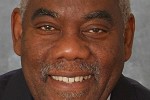By Dr Selwyn R. Cudjoe
November 20, 2019
 ‘Oh Lord, how manifold are thy works: In wisdom hast thou made them all: The earth is full of thy riches.’ -Psalm 104
‘Oh Lord, how manifold are thy works: In wisdom hast thou made them all: The earth is full of thy riches.’ -Psalm 104
GROWING UP in St Mary’s Anglican Church, Tacarigua, I took pleasure in singing the Anglican hymn, ‘All Things Bright and Beautiful’.
It counselled: ‘All things bright and beautiful/all creatures great and small/all things wise and wonderful/the Lord God made them all.’
St Mary’s Anglican Church was erected in 1843 as a place of worship for the Anglicans in the Tacarigua area. Five years later, Cecil Frances Alexander wrote her inspirational hymn for children and published it in Hymns for Little Children. It became one of my favourite hymns.
In that rustic church, I listened ‘in awe and in pleasure, and in the pleasure of awe’ (Ralph Ellison, Invisible Man) as pastors and lay readers intoned their messages from the main pulpit located in the north-eastern corner of the nave of the church.
I heard the following words at the foot of that altar: ‘Each little flower that opens/ Each little bird that sings/He made their glowing colours/he made their tiny wings./ The rich man in his castle/The poor man at his gate/God made them high and lowly/ And ordered their estate.’
Over the years, I ruminated over the words of that hymn. I hum it as I work and marvel at the beauty of nature. I have read many books on faith, visited many cathedrals and heard sermons by famous preachers, yet there is still something uplifting in the belief that all things ‘bright and beautiful, the Lord God made them all’.
Imagine my conflicting emotions when I read the various responses to the use of the Holy Trinity Cathedral as a site for a modelling show. Bishop Claude Berkley, the head of the Anglican Church, described the event as a ‘sad deterioration of respect and modesty’.
Shelley Ann Tenia, dean of the cathedral, said the organisers of the fashion show flouted her instructions: ‘I said I am ok once I see no bumsees or boobs and if anyone has any way that makes that impossible, then they need to not show it or use wraps and sarongs, and the models must have on leggings.’ (Express, November 7.) Women’s breasts and buttocks were the offending items or, as Dean Tenia, put it: ‘It was women modelling scanty swimsuits at the altar and in the aisle of the holy place’ that desecrated the holy site.
Tenia confesses that StyleWeek, the organisers of the fashion show, told her there would be ‘Carnival costumes as well’. And that’s where the problem lay.
Carnival is ‘a celebration of the flesh’. A person cannot display a Carnival costume without displaying and celebrating the flesh, which includes ‘bumsees and boobs’.
Western Christianity (as opposed to Eastern Christianity which originated in AD 42 under St Mark) came into being in AD 325 at the Council of Nicaea, where the churches came together to settle their doctrinal differences. The Roman Emperor Constantine I, an unbaptised person, presided over this meeting that produced the Nicaean Creed that proclaims our belief in one God. Anglicans recite that creed every Sunday.
Christianity became the official religion of Rome in AD 324, but Constantine continued to worship the sun and pagan symbols. He took part in the pagan rituals which the Catholic Church had overlaid with Christian meanings. For example, ‘The widely licentious feast called Saturnalia, dedicated to Saturn, the god of agriculture and to wine… became the Roman Empire’s celebration of Christmas on December 25’ (Lynne Guitar, The Origin of Carnival).
However, Saturnalia, the original festival with its licentiousness, was postponed to the earlier part of the year and named Carnival. It occurred one week before Lent, which consisted of 40 solemn days of penance and sacrifice in which one renounces the pleasures of the flesh. This why women, primarily, who enjoy showing off and revelling in their flesh during the Carnival festivities then rush to church on Ash Wednesday for their ashes to be forgiven of their venial sins.
Bishop Berkley declares that ‘the depiction of scantily clad models parading along the aisle of the church offended individual and collective sensibilities locally and internationally’ (Express, November 6). However, people who see Carnival as a celebration of the flesh and the transgression of boundaries were not troubled enormously.
The human body is aesthetically pleasing. Fashion shows that include scantily clad models parading in the aisle of a church should be done tastefully and artistically, if they are done at all. Paul Richard has observed: ‘More than any European since the Golden Age of Greece, Michelangelo accepted the human form as god-like.’ (Washington Post, October 27, 1996.) If God made the earth and all there is within it, then we should not be unduly upset about displays of the human body. Not only did God make all things bright and beautiful, ‘He gave us eyes to see them/And lips that we might tell/How Great is God Almighty/Who made all things well.’
Bishop Berkley promises: ‘There will be some act of rededication to renew our commitment to the worship of the Holy God and for the calming of very troubled hearts and minds.’ (Express, November 7.) I wonder if God, in his majesty and his glory, is offended by the display of some bumsees and some boobs. He would have advised: ‘Let not your heart be troubled. You believe in God.’
I sympathise with Bishop Berkley and members of the Anglican faith. However, they should not be too hard on themselves. God will understand their shortcomings.
